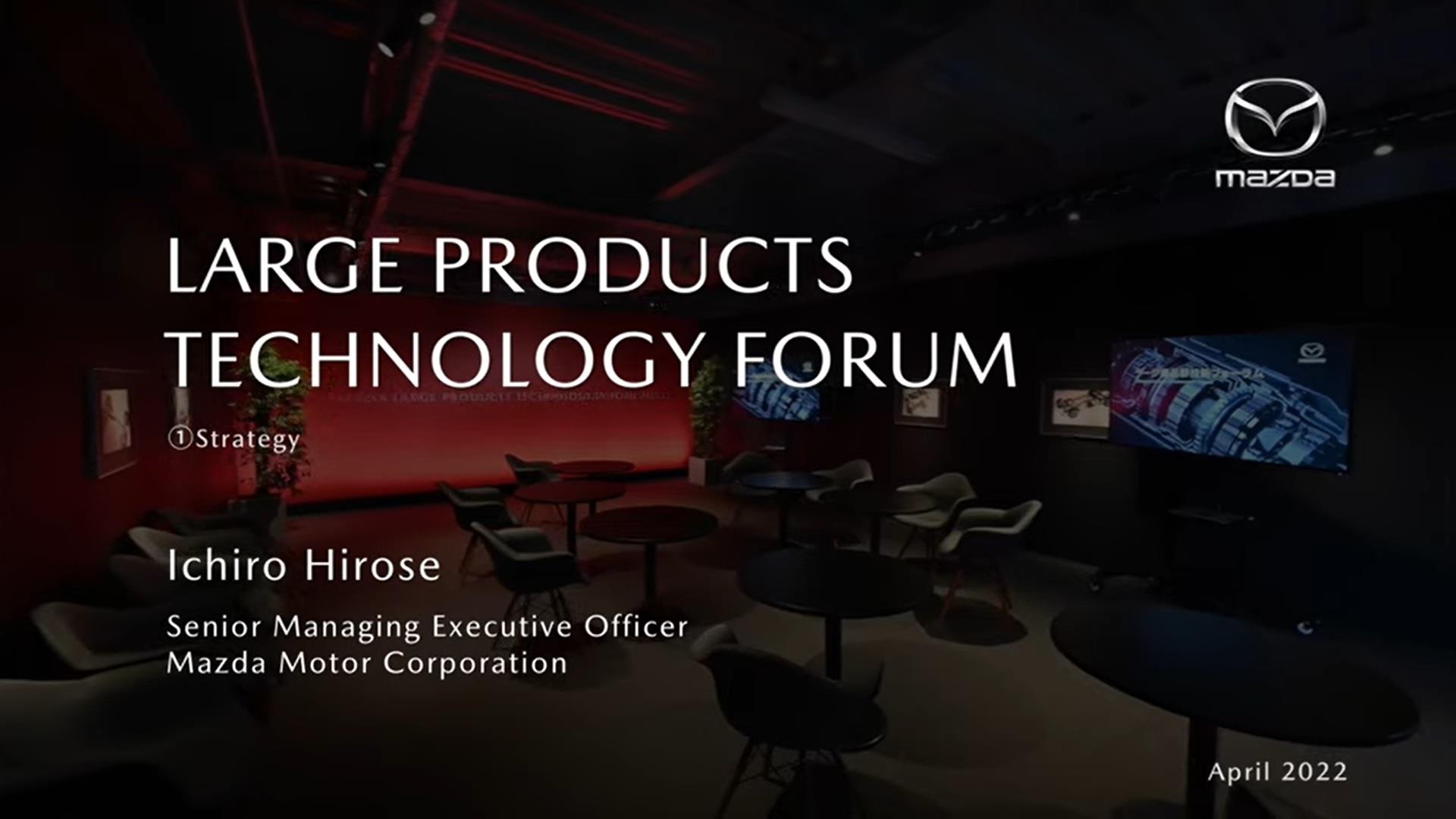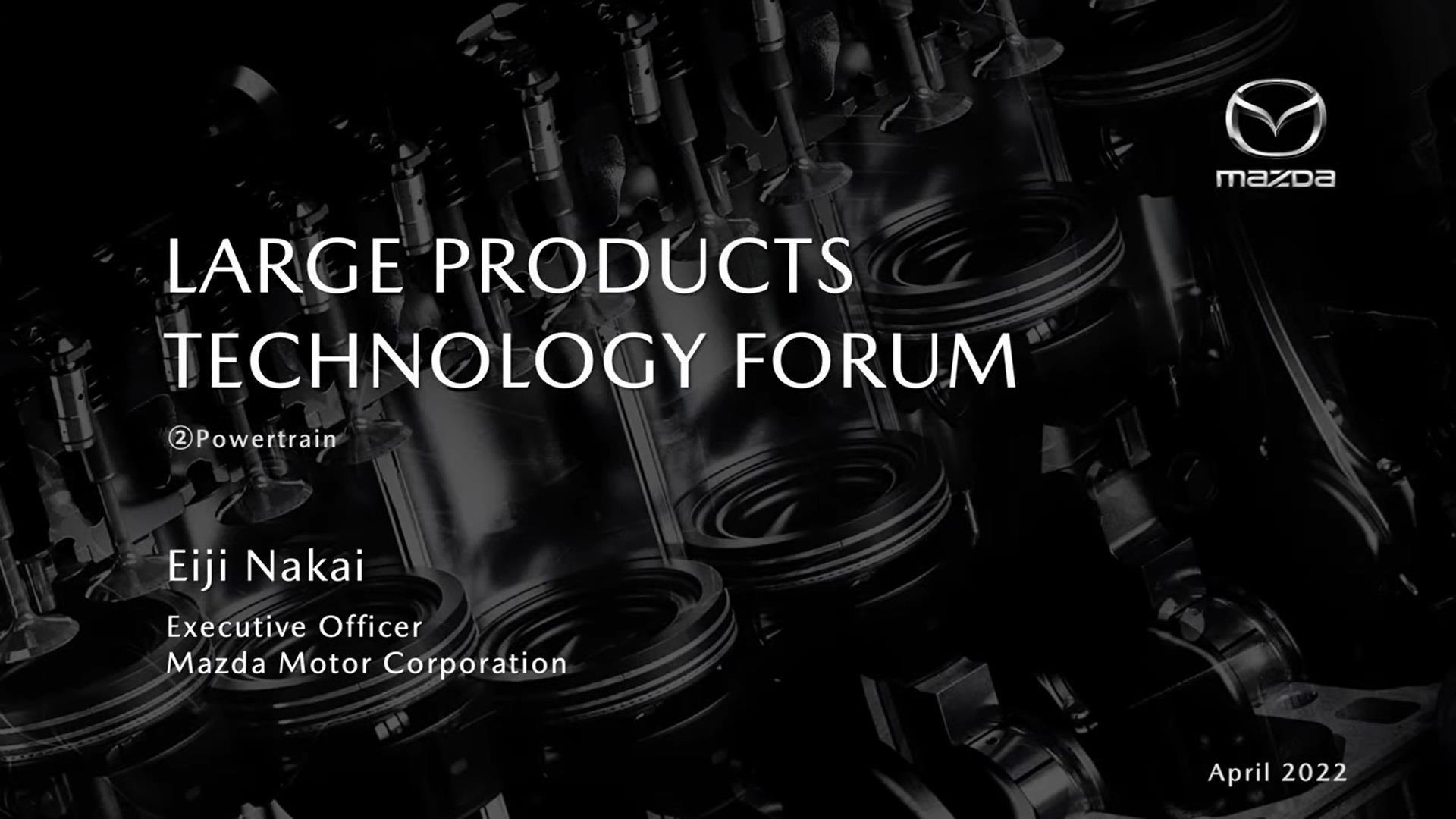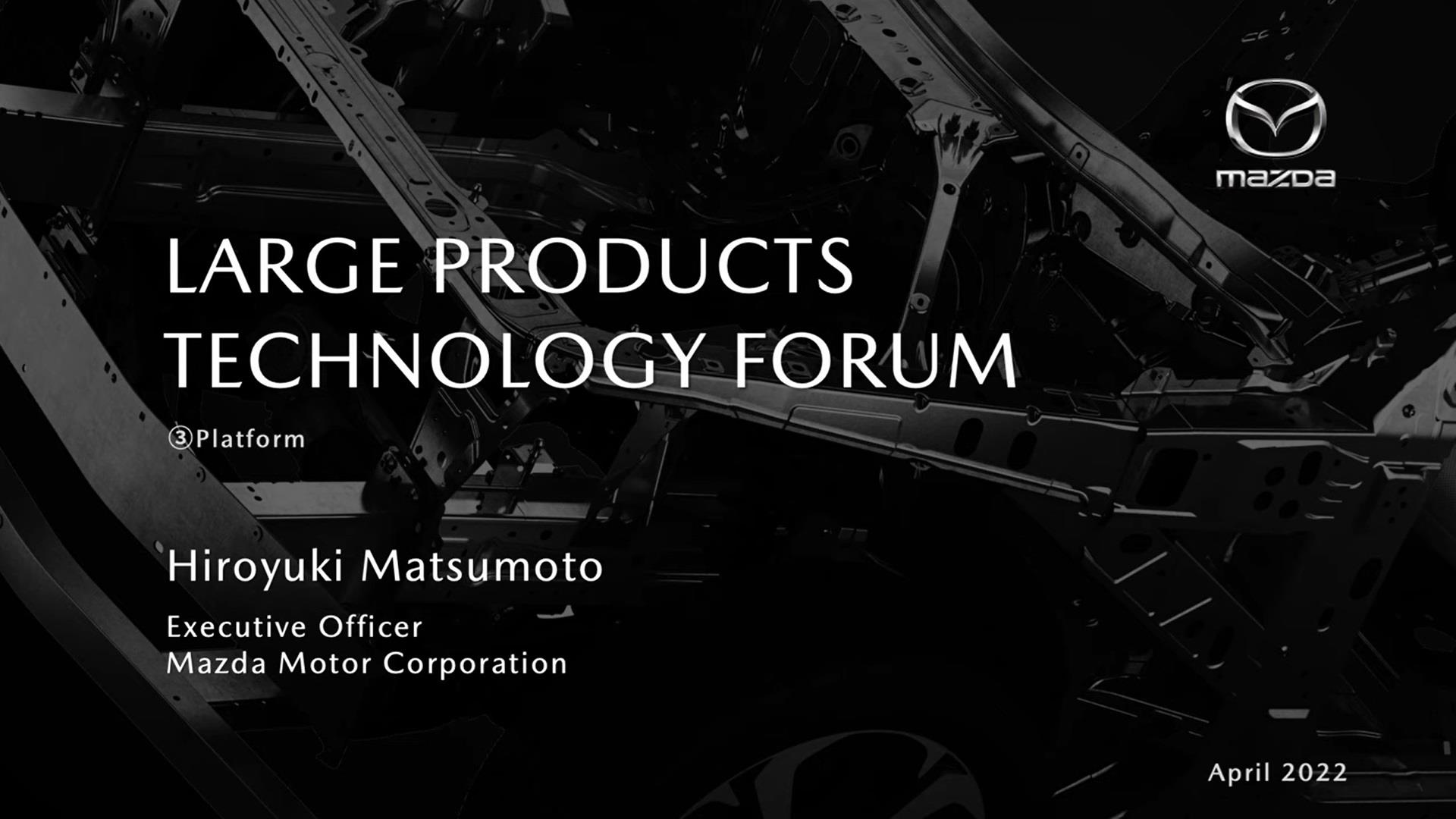LARGE PRODUCTS TECHNOLOGY
Large products developed with a focus on reducing environmental burden and enhanced product value
Mazda’s Large Products Technology refers to a group of technologies applied to four large SUV models that are globally launched by the end of 2023. The Technology was developed to further reduce environmental burden during a transition to EVs, and to deliver enhanced product value that caters to the needs of customers seeking premium models.
To reduce environmental burden, Mazda developed new Multi-solution Architecture for use in longitudinal power units, so that appropriate combinations from Mazda’s engine line-up: mild hybrid engine, plug-in hybrid engine, straight-four and straight-six gasoline, and straight-six diesel engines, are provided to meet the local regulations and customer’s requirements in different markets and regions.
To prepare for once-in-a-century paradigm shift in the automotive industry that is increasingly defined by CASE, Mazda’s Large Products Technology is aimed at achieving essential reduction of energy consumption.
In addition, based on the company’s ongoing pursuit of human-centric development philosophy, the Large Products Technology has been reinforced with software-first structure that enables delivery of diverse values in a highly efficient manner.
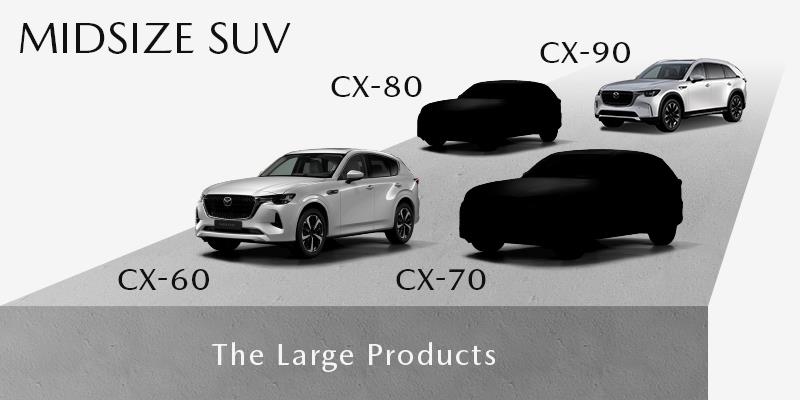


CONCEPT
Achieving essential reduction of environmental burden
As a part of its initiatives to achieving carbon neutrality by 2050,
Mazda has adopted the Multi-Solution approach and set an essential CO2 emission reduction goal
from a Well-to-Wheel perspective.
- Multi-Solution
-
Each local market has its own legal regulations, infrastructure challenges and the way people use cars. In short, car companies need to cater to broad, diverse needs around the world.
To provide the “right” models to every market, Mazda has developed SKYACTIV Multi-solution Scalable Architecture for providing appropriate combinations of internal combustion engines and electrification technology to each market.


Mazda’s Large Products Technology is built upon its Multi-solution Architecture,
which was developed for use in a longitudinal power unit that accommodates mild hybrid, plug-in hybrid,
straight-four and straight-six gasoline, and straight-six diesel engines.
The Technology is being applied to Mazda’s Large Products, a group of four midsize SUVs that are bigger than the MAZDA CX-5 and CX-50
with a broader price range, to be launched by the end of 2023.
The purposes of the Large Product group are two-fold:
1 Further reduction of environmental burden
caused by internal combustion engine models
during the transition to EVs
- ● Improving efficiency of engines by increasing engine displacement and cylinders.
- ● Launching appropriate P-HEVs/M-HEVs that suit each country’s policies and infrastructure. (enhancing scalability of electrification technologies based on Common Architecture Concept.)
2 Enhanced product value that satisfies
the needs of customers seeking
premium models
- ● Powerful driving dynamics for the driver to confidently navigate bigger-sized vehicles powered by bigger displacement engine.
- ● A unique proportion paired with outstanding handling stability.


The automotive industry today is going through once-in-a-century paradigm shift.
To keep up with the current requirements best represented by CASE– Connected (IoT), Autonomous driving (Autonomous car),
Shared (Car sharing) and Electric (EV), Mazda has adopted the following three policies.

1 Achieving carbon neutrality by 2050
As the world is clearly shifting toward EVs, saving energy consumption is the most critical issue. In addition to addressing alternative fuels such as carbon-neutral liquid fuel and biofuel, improving efficiency of internal combustion engine to a level set as a goal is paramount.
2 Stretching value proposition
Building upon Mazda’s history of manufacturing cars that meet the safety standards, evolving hardware performance by controlling software is an efficient way of delivering broader value proposition for today and in the future.
3 Human-centric development philosophy
Mazda believes that being in control of a vehicle with full confidence revitalizes the driver, both physically and mentally.
And we are not just talking about experienced drivers.
By engaging different drivers through driving, Mazda hopes to energize every driver and help him/her embrace a more active attitude to life.
Full presentation video
(duration: 10 minutes 29 seconds)


POWERTRAIN
Based on a platform with a longitudinal engine layout, Mazda has developed new electric drive systems such as plug-in hybrid, 48v mild hybrid system,
as well as torque converter-less 8-speed AT and AWD system on top of existing straight-six SKYACTIV-G/D/X engines.
Three key points
1 Environmental performance
Adapting to alternative fuel, improving gas emission performance and achieving carbon neutrality are a few examples of Mazda’s initiatives to improve its environmental performance.
2 Driving dynamics
Enhanced quality of driving was achieved by use of highly responsive, direct and dynamic power source.
3 Mental invigoration
Seamless acceleration, direct feel, responsiveness, and rhythmic driving realized by 8-speed AT and ideal pedal work space are all aimed at invigorating driver’s heart and mind.

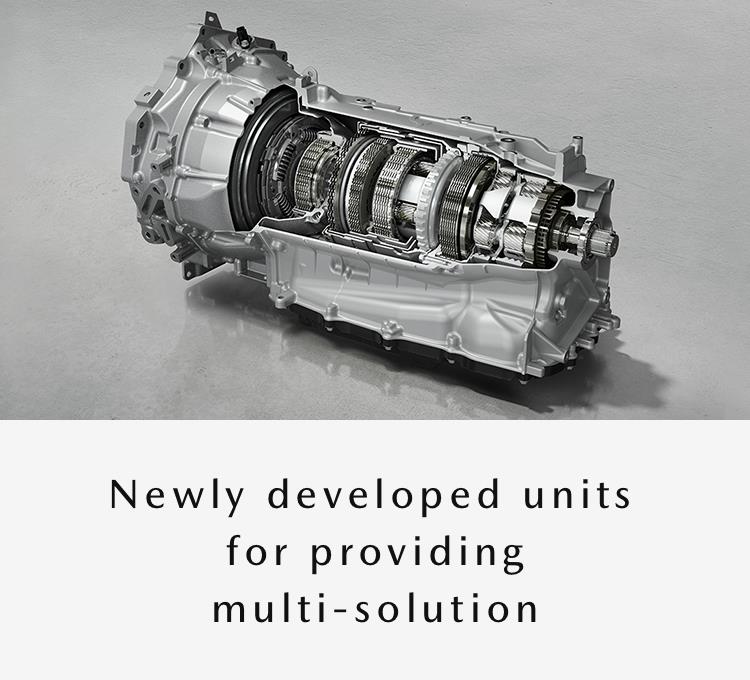
Based on a platform with a longitudinal engine layout,
Mazda has developed new electric drive systems such as plug-in hybrid, 48v mild hybrid system,
as well as 8-speed AT without torque converter and AWD system on top of existing inline-six SKYACTIV-G/D/X engine.
Discover more about some of Mazda’s newly developed engines.
- Multi-solution approach enabled by a platform with a longitudinal engine layout
-
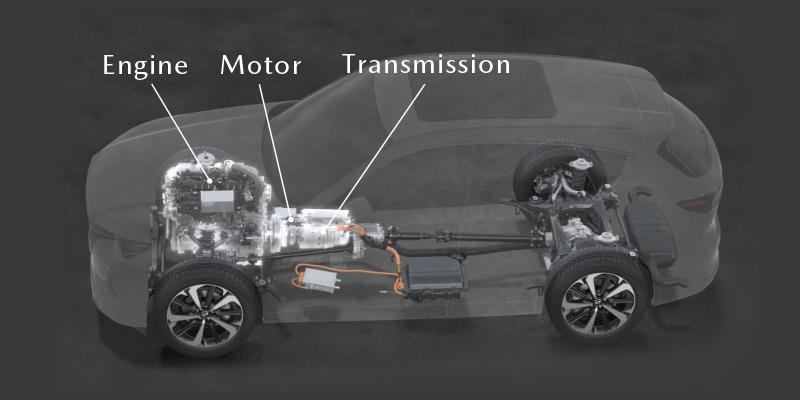
Placement of engine, motor and transmission on the same axis contributed to efficient development of diverse powertrain combinations. The platform is also leveraged to provide multiple solutions that address energy situations in each country and region, as well as local/regional customer needs.
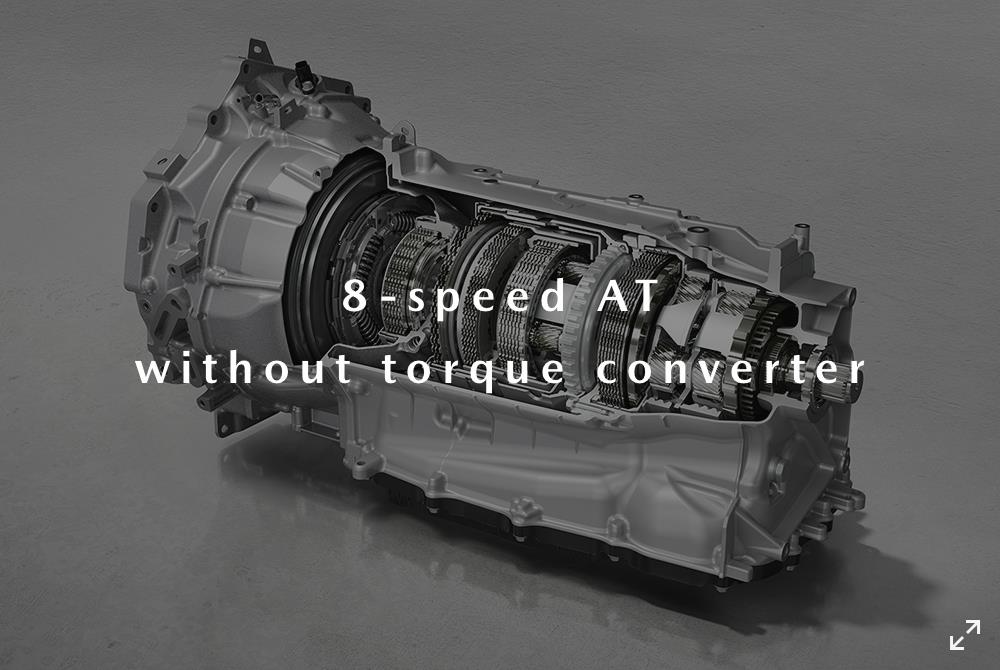
Using a mechanical clutch mechanism, typically used in manual transmission, instead hydraulic torque converter resulted in direct start response, highly-responsive and smooth shift change performance, and light-footed, rhythmical driving that feels comfortable to human senses. Exhilarating driving and enhanced environmental performance were realized by approximately 22% reduction of transmission resistance against the previous model.
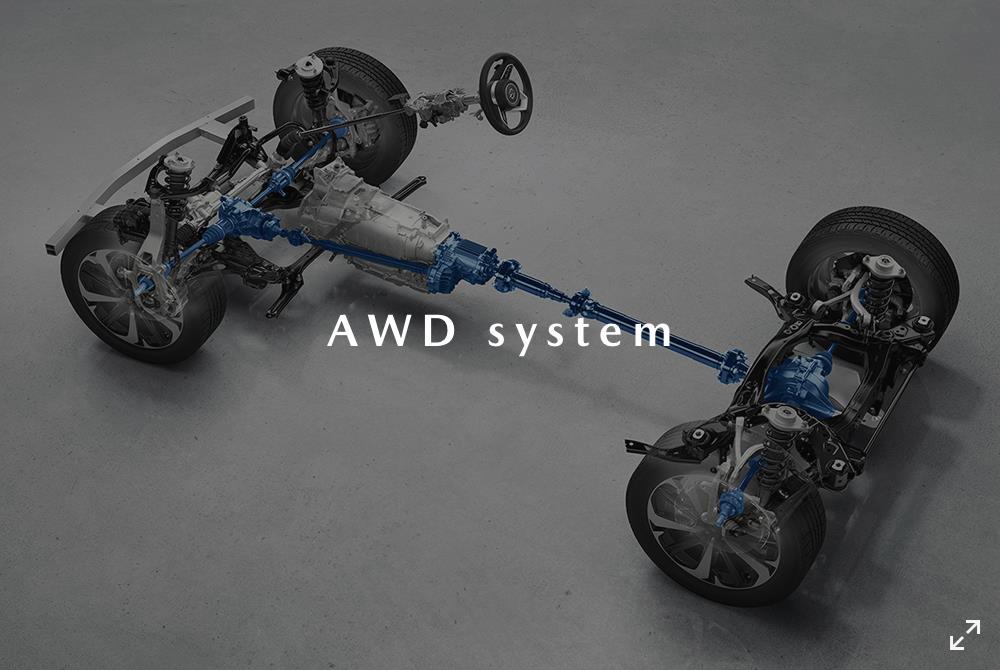
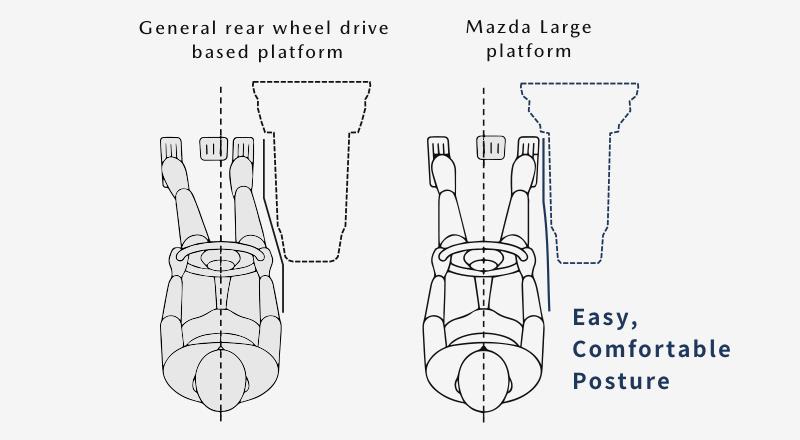
Mazda’s AWD system is rear wheel drive-based with electrically controlled multi-disc clutch, designed to provide excellent performance. Driving power is optimally allocated to four tires to bring out target vehicle driving performance. Resistance was also reduced to reduce fuel consumption, and ideal driving position was secured by optimizing the powertrain package layout.

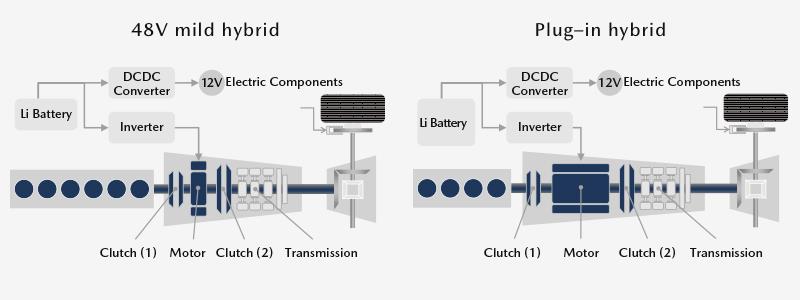
48V mild hybrid and plug-in hybrid are designed as a scalable system.
Detaching the engine and motor/generator enabled use of efficiently recovered energy to assist acceleration and shift change.
The result is improved environmental performance, quicker acceleration response and responsive shift change.

A motor combined with a large displacement engine in 48V mild hybrid effectively covers ultra light load area (idling to low-speed area),
which is a weakness against a smaller displacement engine, and contributed to improving environmental performance.
A large motor mounted in plug-in hybrid covers small to medium engine.
Combining the motor with SKYACTIV-G 2.5-liter engine that has low to medium engine load fuel consumption resulted
in striking the right balance of environmental performance and driving dynamics.

Mazda’s pursuit of ideal combustion and increase of engine displacement realized a clean, highly efficient and high-output SKYACTIV-D 3.3-liter straight-six engine. Use of a stepped egg-shaped combustion chamber and a high-pressure fuel injection for Distribution-Controlled Partially Premixed Compression Ignition (DCPCI), as well as large engine displacement, worked to achieve more than 40% thermal efficiency in considerable part of the practical operating range. In addition, reduction in fuel consumption and NOX emission was achieved in all areas, and the quality of driving was enhanced by improving engine torque.
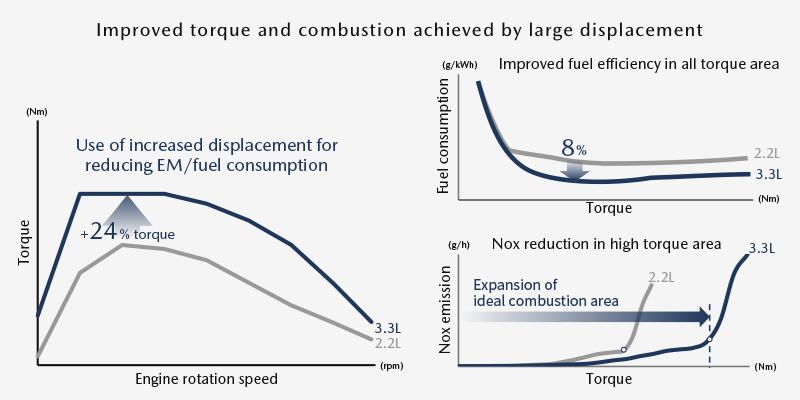
To prepare for the future where carbon-neutral fuels are commonly used, Mazda is pushing R&D on combustion technology so that the same level of performance will be secured with biofuel.

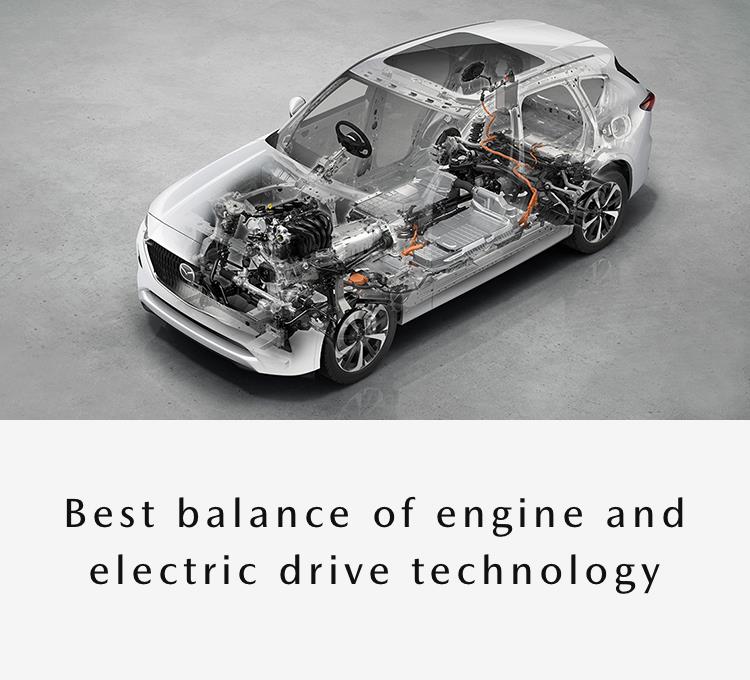
- e-SKYACTIV D
-
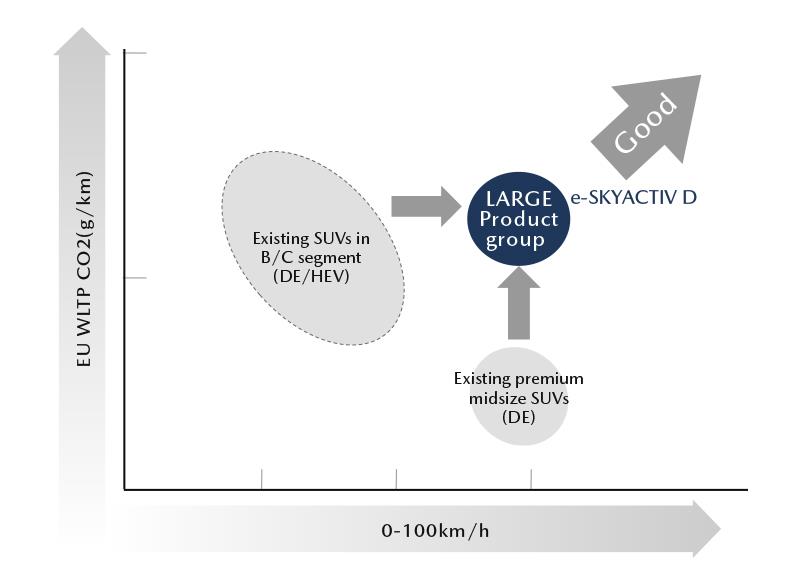
Combining the 3.3-liter straight-six diesel engine with a small motor and a battery , Mazda’s 48V mild hybrid e-SKYACTIV-D strikes the excellent balance of powerful torque required to drive the large product group, clean exhaust gas performance and fuel consumption performance.
- SUVs in B/C segment: vehicles with overall length between approximately 3,700mm and 4,500mm.
- Existing premium midsize SUVs (D segment): vehicles with overall length between approximately 4,500mm and 4,800mm.
- e-SKYACTIV PHEV
-
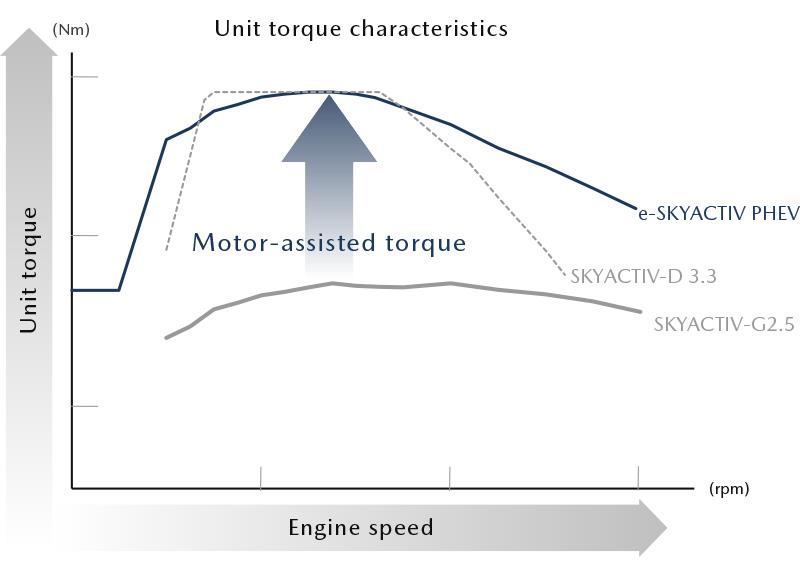
The 2.5-liter straight-four SKYACTIV-G engine is paired with a big motor and a battery to enable battery-powered EV driving for daily occasions. The engine delivers big torque and high output, yet driving power and control are precise enough for greatly enhanced “Jinba Ittai” driving experience.
Full presentation video
(duration: 11 minutes 17 seconds)

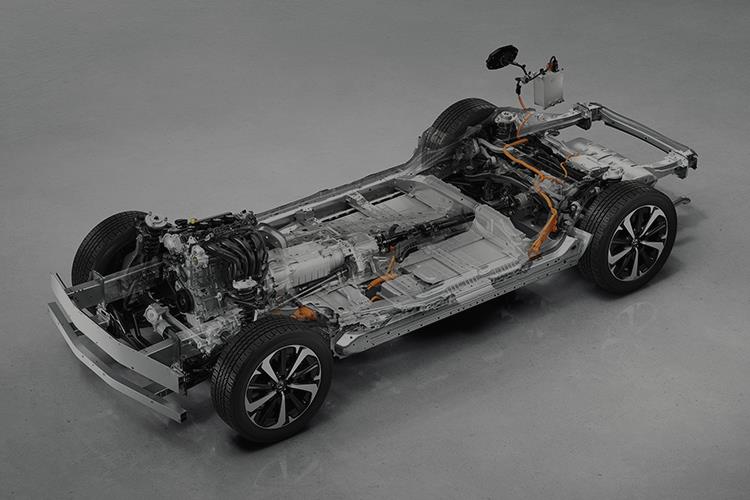
PLATFORM
Evolving “human-centric design”
Mazda is a car company that celebrates driving by delivering “Jinba Ittai” driving experience.
Like a horse rider who is at one with its horse, Mazda wants drivers to be touched, energized and gain confidence in driving, and share the joy of travel with their passengers through a comfortable cabin space.
To achieve this vision, Mazda has adopted a unique approach based on its “human-centric product development philosophy”, which was further evolved for the Large Products Technology.

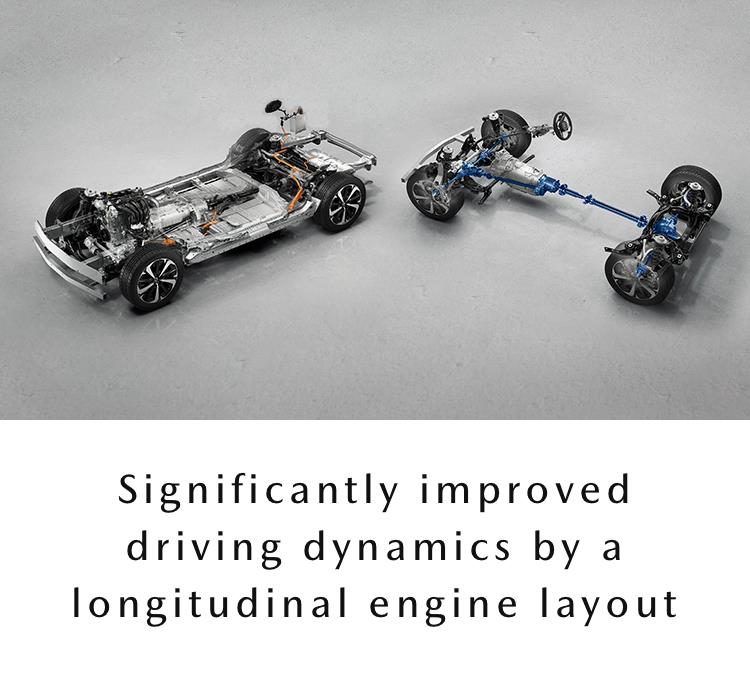
For a platform characterized by a longitudinal engine layout and rear wheel drive-based AWD,
an ideal front-rear weight distribution was achieved to equalize weight on each tire. Together with fine handling and enhanced stability, driving dynamics was greatly improved by combining AWD with rear wheel drive.


To create vehicles with bigger power and size that drivers can control with confidence, like an extension of their body, Mazda paid attention to how people can use tools, such as chopsticks and hammers, like a part of their body (physical expansion capability). With this in mind, Mazda worked on “vehicle’s swift response to driver’s operation (synchronization) ,” “maintaining synchronization by eliminating the impact generated by disturbances, such as uneven road surface and change of driver’s operation,” and “design that enables driver to feel the vehicle response through five human senses.”
- Vehicle’s swift response to driver’s operation (synchronization)
-
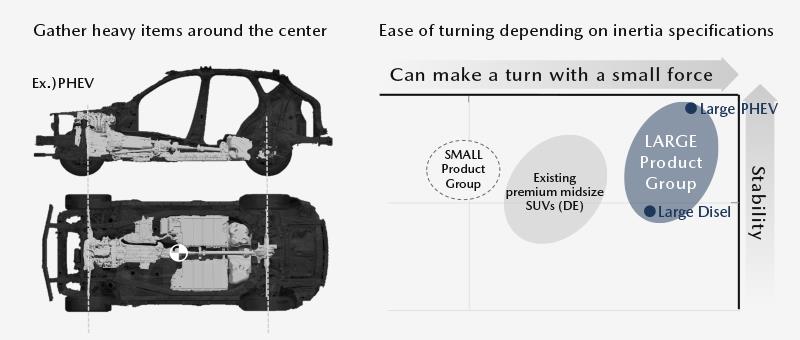
Taking advantage of the benefits of the longitudinal engine layout architecture, heavy parts are mounted at the center of vehicle’s gravity. This reduced inertia mass and converts force generated by four tires into a turning motion without delay.
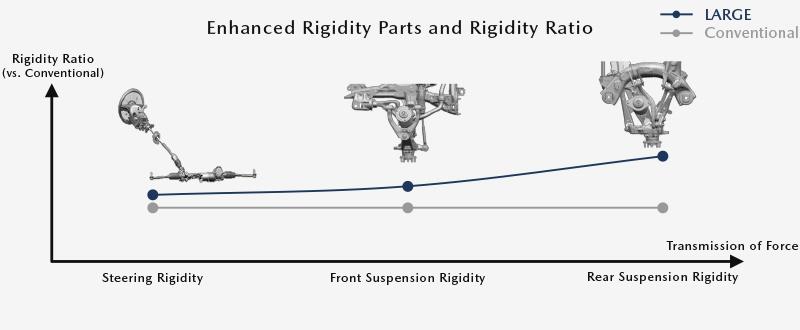
From steering, front suspension and to rear suspension rigidity, stiffness is increased downstream in the order of force transmission as a result of reviewing an overall rigidity distribution. Synchronization of vehicle’s response to the driver’s operation is accelerated by seamless force transmission.
- Maintaining synchronization by eliminating the impact generated by uneven road surface and change of driver’s operation
-
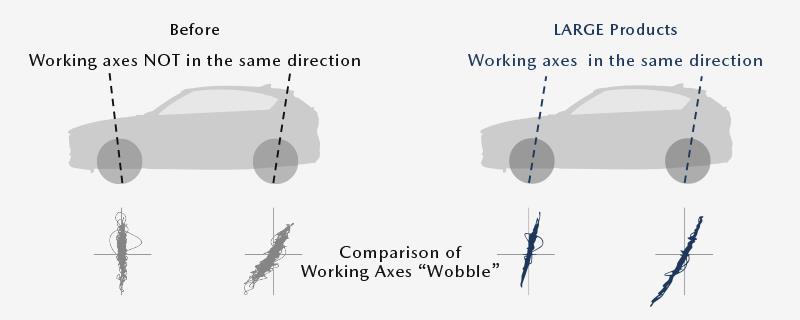
Stabilizing cabin’s motion caused by external disturbance, such as change in road surface, is critical. That is why double wishbone front suspension and full multi-link rear suspension were selected for SUVs in Mazda’s Large Product group. Strokes are smoothed by aligning tire’s upward and downward directions of motion, and spring follows a vehicle’s turning force in a simple motion. This ensures stable synchronization with the driver’s operation.

Suspension was designed to maximize Kinematic Posture Control (KPC), a vehicle dynamics control technology that is designed to reduce roll during cornering and lowers the vehicle body to stabilize turning posture. The outcome is a highly efficient vehicle turning posture.
- A design that allows the driver to accurately feel the vehicle response through all five senses
-
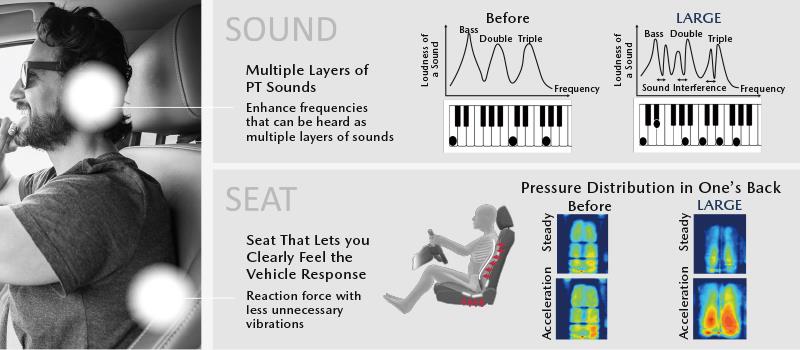
Mazda takes the “richness of sensory stimulation” seriously, which translates to a seat that connects driver and vehicle, and engine sound. By using a design that allows the driver to accurately feel the vehicle response through five human senses, such as the seat’s pressure on the back as the driver further pushes on the accelerator pedal, profound sound and fluctuating line of sight, the state of synchronization with the vehicle and an uplifting driving feel are reinforced.


To evolve vehicle handling stability, Mazda leveraged human capabilities to give drivers an “at-will” control of their vehicle.
Both drivers and passengers are less likely to feel carsick or fatigue from being in a driving vehicle.
Driving feels increasingly enjoyable and rhythmical.
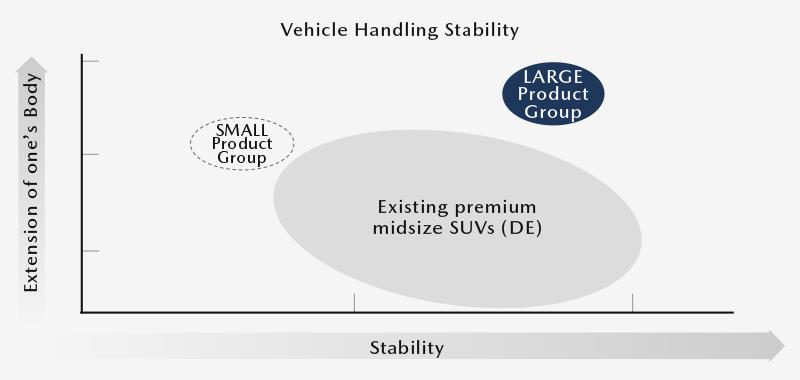
The new dimension of vehicle control experienced by the driver

Enhanced ride comfort and driving rhythmicality
Full presentation video
(duration: 12 minutes 21 seconds)

